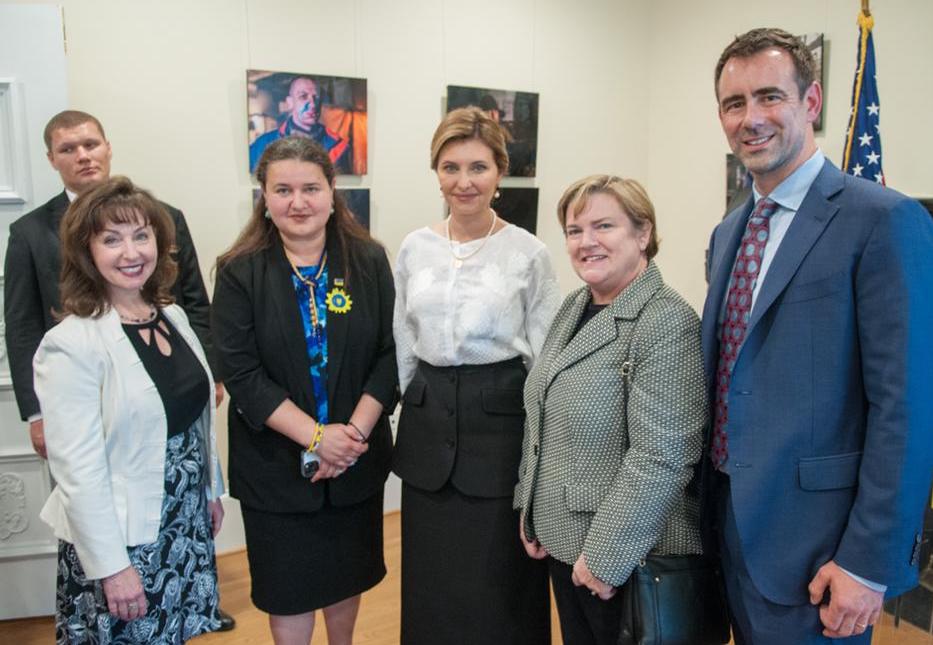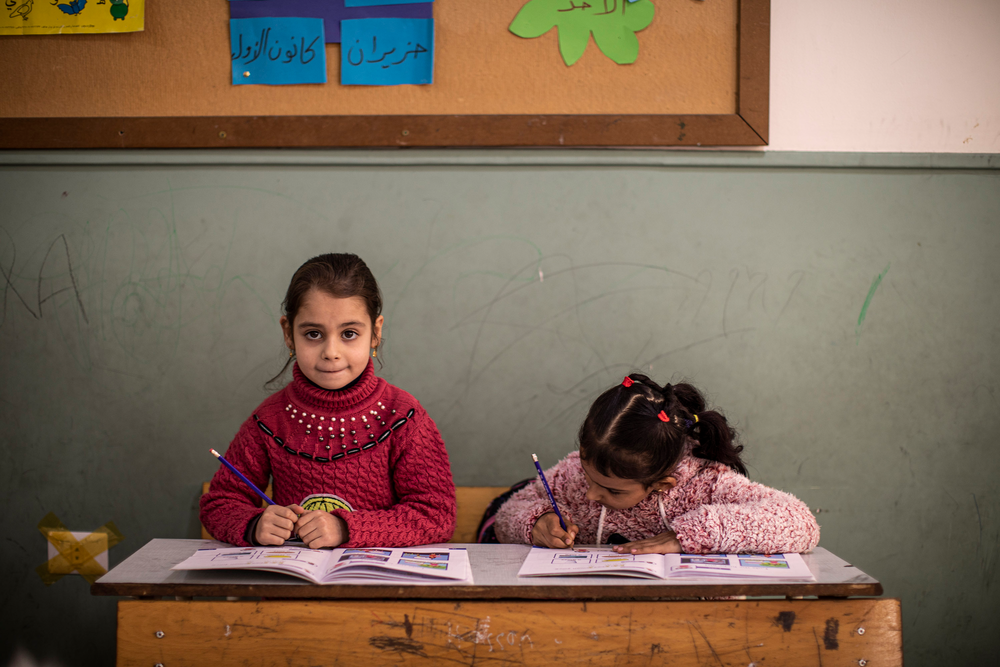
Chibok two years on: how Safe Schools Initiative is bringing hope to Nigerian children
Chibok girls, Children in conflicts, Education in emergencies
Nigerian student Naomi Jacobs attends a double-shift school in Maiduguri for displaced children in camps Picture: UNICEF/Esiebo
The headlines are about the despair and the tragedy. Two years after the Chibok schoolgirls in Nigeria were abducted by Boko Haram, that is understandable.
Of the 276 girls captured on April 14, 2014, 219 are still missing. About 2000 girls and boys have been kidnapped since the start of 2014. One in five “suicide bombers” used by Boko Haram is a child – some as them girls as young as eight.
And more than 900 schools have been attacked and 600 teachers killed, forcing hundreds of thousands of children out of education in a country where more than 10 million were already deprIved of schooling.
But behind those horrific statistics there is hope, in the shape of the Safe Schools Initiative.
Based on a concept from A World at School and the Global Business Coalition for Education, the initiative was launched just weeks after the Chibok abductions.
Working with Gordon Brown – the United Nations Special Envoy for Global Education – it brought together Nigerian businesses, the government, donors and humanitarian agencies and raised an impressive $30 million in funding.
Its ambitious aim was to reach 500 schools in the northern states most affected by the Boko Haram insurgency, providing a programme for the protection of schools and the prevention of attacks.
Two years on, the UN children’s agency UNICEF has reported the Safe Schools Initiative has seen 213,985 internally displaced and vulnerable children enrolled in schools in camps and host communities. Almost half of those were girls and double-shift schools have been part of the strategy.
Nigerian students use new school supplies at UNICEF supported safe space for IDPs in Maiduguri Picture: UNICEF/Esiebo
Terry Durnnian, Chief of Education at UNICEF, said: “To address the immediate educational need of internally displaced children, the Nigerian government launched the Safe Schools Initiative in 2014 with support of the UN.
“UNICEF has been able to lead SSI’s third objective – access – by implementing activities to increase access to quality education for internally displaced and vulnerable children In four states in northeast Nigeria, with support from the Norwegian Ministry of Foreign Affairs.”
Mr Durnnian said the Safe Schools Initiative has also trained more than 550 teachers, established 112 temporary learning spaces and created state co-ordination committees for education.
Boko Haram violence has had a huge impact on education in Nigeria, Cameroon, Chad and Niger.
Mr Durnnian said: “Violence has kept over 670,000 children out of school and over 1800 schools remain closed due to the conflict because they have been attacked, looted, set on fire or used as shelter by displaced people.”
Gordon Brown was instrumental in the establishment of the Safe Schools Initiative. Today – at an event held by the Global Business Coalition for Education in Washington, DC, he said: “It is two years since the Nigerian girls were kidnapped in Chibok.
“We must also remember that the result of that was the Safe Schools Initiative started by businesses in Nigeria – a partnership between businesses, government and politicians.”
In a blog for A World at School, Mr Brown said: “All governments should now support a Declaration on Safe Schools, stating that attacks on schools, colleges and universities are crimes against humanity.
“And the international community should ensure the funds for guards, for cameras and simple gates to protect schools in conflict zones.”
TIMELINE OF THE SAFE SCHOOLS INITIATIVE IN NIGERIA
APRIL 2014
Boko Haram abducts 279 students from the Government Girls’ Secondary School in Chibok, Borno state. Some escape immediately – but two years later 219 are still missing.
MAY 2014
A World at School and the Global Business Coalition for Education publish a report titled The Safe Schools Initiative: Protecting the Right to Learn in Nigeria.
It recommends a combination of school-based interventions, community-based interventions to protect schools and special measures for at-risk populations.
The SSI Nigeria is launched at at the World Economic Forum in Abuja, with the aim to reach more than 500 schools in the northern states.
Funding comes from $10 million pledged by a coalition of Nigerian business leaders, working with the UN Special Envoy for Global Education Gordon Brown, GBC-Education and A World at School. It is matched by another $10 million from the Nigerian government.
The initiative’s longer-term aims will focus on bolstering the physical protection of schools, providing school guards and police in partnership with Nigerian authorities, training staff as school safety officers, and providing communications tools and school counsellors.
A World at School launches a Safe Schools campaign targeting the donor community. Theirworld – the children’s charity behind A World at School – makes the first donation to a UN Multi-Donor Trust Fund to support activities in the three states of emergency in the north. This jump-starts a new donor platform.
These efforts lead to donors such as the United States, United Kingdom, Norway, Germany and African Development Bank contributing more than $10 million in additional funding to UNICEF, the new UNDP Multi-donor Trust Fund for Safe Schools or to other Safe Schools programme activities.
NOVEMBER 2014
The government says 2400 students from Borno, Yobe and Adamawa states – the hardest hit by the violence – are to be the first enrolled in the Safe Schools Initiative.
MAY 2015
The SSI Secretariat publishes a report one year after the launch of the initiative. It gives updates on three SSI programmes:
Students Transfer Programme – the first 2400 students have been transferred to 43 Federal Unity Colleges and 44 students from Chibok have been included.
Schools Rehabiliation Programme – three schools are identified to pilot this programme in Adamawa, Borno and Yobe states. This includes upgraded infrastructure, physical protection such as fences and alarms, and developing school security and rapid response plans.
Innovative Education Strategies for Children in IDP Camps and Host Communities – double-shift schooling has been introduced for IDP children in Adamawa, Borno, Yobe and Gombe states, with 47,952 children reached (21,861 boys and 19,509 girls).
AUGUST 2015
Sarah Brown, President of the children’s charity Theirworld and Executive Chair of GBC-Education, gives an update on the SSI to mark 500 days since the Chibok kidnappings.
A total of 683 teachers have been trained and 35,000 school bags packed with pencils, pens, books, rulers and exercise books have been distributed to 22,436 IDP learners.
SEPTEMBER 2015
The Norwegian government gives $3 million in additional support to the SSI, with the goal of giving at least 100,000 internally displaced and marginalised children access to education in Borno, Adamawa, Gome and Yobe states.
DECEMBER 2015
A UNICEF report says monitoring of school attendance for newly-enrolled students is happening in Borno and Yobe. In Adamawa, there is a new education commissioner, who is being oriented on SSI and the support it requires.
APRIL 2016
UNICEF reveals the Safe Schools Initiative has enrolled 213,985 internally displaced and vulnerable children in schools.
More news

